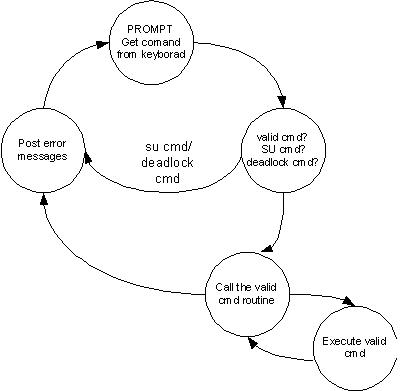
Winux SITS Shell Requirements
Table of Contents
- Introduction
The System (Hierarchical) Instruction Termination Shell (SITS) is a super-user shell to allow termination of processes in order to relieve deadlock situations, as well as to help the system administrator secure the system. It also serves a secondary purpose of debugging for the Winux Operating System.
System (Hierarchical) Instruction Termination Shell
- Allow the super-user to terminate any process in Real Time.
- Authentication of super-user only - special password.
- Special Key Combo Access
- Local System Access Only -> No Remote Access Permitted.
- Highest System Priority Shell - only when accessed.
- All other tasks are pauses while the user is accessing this shell.
- Commands
- User Commands
The system administrator may grant special users developer rights within the system. These rights give the user access to the SITS console, and the ability to modify processes that belong to them, much like in a Unix/Linux environment. However, the abilities of the SITS console go far beyond that of the Unix/Linux environment and allow a much more intimate relationship between the developer and the operating system in the debugging process by providing the developer access to job control, resource control, and placing watches on system objects rather than simply the objects within their program.
Requirements Home Table of Contents
Note: For non-super user developers, the system will only responde to processes that they control, as opposed to super users that will be able to control all processes. - Super User Commands
The following table lists and describes the commands available to the super user.
Requirements Home Table of ContentsCommand Description Add <user> Grants the user access to the SITS shell. Password Allows the super user to change the password of themselves or another user. This command is also extended to the non-super user users. Debug Enters into debug mode so the super user can determine which process is the offending process. The system will return continue running, and will break out when processes ask for resources. The super user may add watches on the resources so as to determine which kind of resource is causing the problem. Exit Shell Returns the system to normal usage. List Processes Lists all the processes, and their usage of the system resources as well as other needed information. Remove <user> Removes the user from the list of those who have been granted access to the SITS shell. Restart Process Allows the super user to restart a program. This is useful where the program is necessary for the system to run, but is doing things it should not, and may be fixed by restarting it. The program will be completely cleaned up so there were no traces of it, and then started again. Execution will begin when the user leaves the shell. Terminate Process Allows the super user to terminate an offending process. - Debugging Commands
The following table lists and describes the commands available for debugging.
Requirements Home Table of ContentsCommand Description Allow Tells the system to grant the request of a resource by a process. The system will continue operation when this has been selected. Continue Tells the system to continue. Default is to do what the system would have normally done had the watch not been enabled. Deny Tells the system to deny the request of a resource by a process. The system will continue operation when this has been selected. Show deadlock diagram Display a diagram of the resources and the processes that are controlling them. Processes are identified by their PID number. This is to help in determining when a process is hogging a certain resource. Show <resource> Shows the statistics of usage and ownership of a resource by processes by the PID. Watch <resource> Like a variable watch when debugging applications but for system resources. The system will notify the super user when a resource has been requested. It is important to note that resource wathces will not traverse rebooting the computer.
- User Commands
- Flow Diagrams
- Level 0
Requirements Home Table of Contents
- Level 1
Requirements Home Table of Contents - Level 2
Requirements Home Table of Contents
- Level 0
- Super User Password Access Scheme
The SITS shell will have its own special password storage and maintenance system. The passwords will be stored in an area only accessible by the SITS shell and the system itself. The Super User will have the ability to add/remove users, and change passwords for the users. Users will also be able to change their own passwords.
Requirements Home Table of Contents
- Glossary
Requirements Home Table of Contents